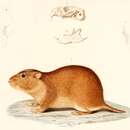en
names in breadcrumbs


The Brazilian tuco-tuco (Ctenomys brasiliensis) is a tuco-tuco species.[2] It is found mainly in the state of Minas Gerais in southeastern Brazil,[3] though Charles Darwin mentions it during his trip through present-day Uruguay.[4]
The Brazilian tuco-tuco has a reddish-brown coat color. The tail has short hairs covering it. It is the largest species of its genus. The head-body length is about 300 mm and the tail is relatively short.[3]
The Brazilian tuco-tuco (Ctenomys brasiliensis) is a tuco-tuco species. It is found mainly in the state of Minas Gerais in southeastern Brazil, though Charles Darwin mentions it during his trip through present-day Uruguay.